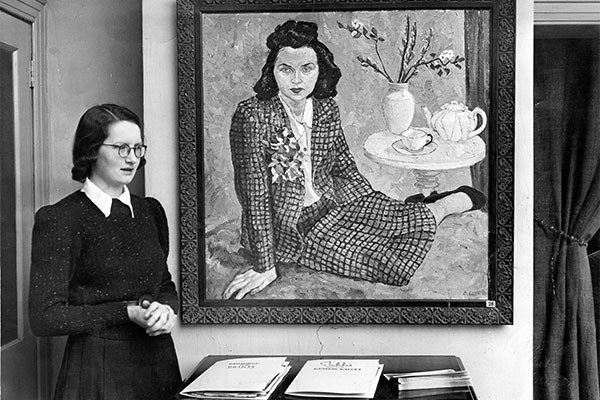Nude sculpture, a freaky fish plate, gorgeous florals and sweeping watercolours compile one of the Dunedin Public Art Gallery’s latest exhibitions. This marks the one-hundrenth birthday of Doris Lusk, one of the most prominent New Zealand artists of the twentieth century. In memory of her, the gallery has put together an overview of her work, ranging from sculpture to painting to ceramics.
Doris Lusk was born in Dunedin, then grew up in Hamilton along the banks of the Waikato River. The family moved back to Dunedin in 1928, and Lusk studied at high school here before moving onto the King Edward Technical College to study art. She began creating landscapes, studying under the prominent painter R. N. Field, and also began creating pottery and experimenting with life-drawing. Around the time that Lusk began painting, kiwi artists were obsessing over landscape works including manmade structures like railway stations and bridges. While this might seem standard fare for 2016 artists, this was a brand new approach to painting at the time, making Lusk innovative and trendy. Gasworks and foreshore, Dunedin (c.1935) provides an example of this focus. After leaving school, she held her first solo show at a studio on Moray Place, before traveling to Nelson with friends and marrying engineer Dermot John Tasker Holland in 1942. Lusk went on to exhibit prolifically throughout her life, before being elected president of the Canterbury Society of Arts in 1982, and passing away eight years later.
What’s great about this exhibition is the uniquely local focus held by many of the works. Check out Fountain, Gardens (c.1938) and Two gardeners, Botanic Gardens (c.1935) for strikingly familiar snapshots into olden day Otago. Lusk managed to capture that elusive sense of life in Dunners, a bright hub in the cold of the deep south.
Through pottery and sculpture, Lusk also captured something unique and innovative. Lusk was actually one of the country’s pioneering potters, and worked as a pottery teacher for several years. Reclining Nude (1933) was created when Lusk was only a teenager, but already the small-scale sculpture featured in this exhibition demonstrates the keen eye for shape and line which would later define her oeuvre. If you’re thinking of delving into sculpture for the upcoming OUSA art exhibition, check this piece out for some elegant inspiration.
Overall I found this exhibition pleasing, despite its small size. Doris Lusk was not only a prominent New Zealand painter but a skilled artist across numerous mediums, and this exhibition really showcases this. It also highlights her development as an artist, moving from relatively straightforward paintings through to others which experiment with expressionism, cubism, and colour field styles. Amazing paintings like Rock face, Weka Pass (1961) and Onekaka Beach, Nelson (1966) show off modernist trends in art, creating sweeping and beautiful works of experimental landscapes. This exhibition is both interesting in the range of work which it showcases, and important in its celebration of one of our local and most wonderful artists.



